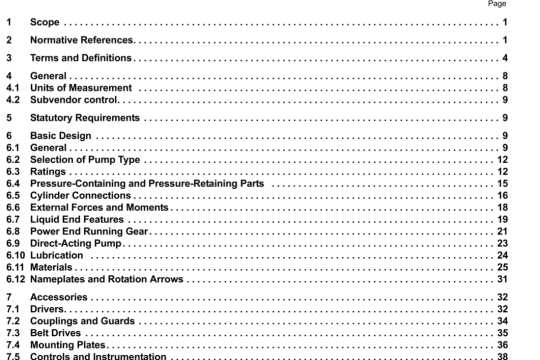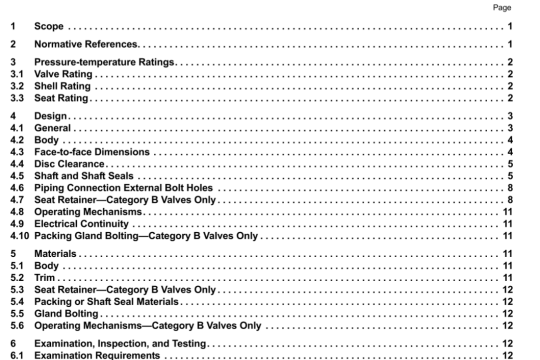API RP 13M:2004 pdf download
API RP 13M:2004 pdf download.Recommended Practice for the Measurement of Viscous Properties of Completion Fluids.
7 Instrument calibratIon
The instruments assodated with these procedures shall be calibrated according to each manufacturer’s recommended methOd.
8 Measurement procedures
8.1 General
The procedures given In this dause are organized based on the type of fluid on which the measurement is carried out. Where data are reported as being obtained using a particular procedure, the procedure given shall be followed exactly. The fluid shall not react with instrument surfaces to generate contaminants, change critical measurement dimensions, or impair proper mechanical operation.
8.2 Non-crosslinked fluids (see 2.6)
8.2.1 IntroductIon
For proper theological characterization of this type of fluid, the fluid shalt wet the walls of the measuring chamber and remain within the annular gap.
8.2.2 Apparatus
For proper visoometnc and rtieolog.cal characterization, the apparatus used shall meet the following criteria:
a) the flow regime in the annular gap is laminar;
b) slippage of the fluid at the walls within the gap is negligible;
C) the fluid exhibits essentially time-independent behaviour during any given measurement.
8.2.2.1 Non-pressurIzed concentrlc.cyllnder viscometerU, to measure viscous and rheoIogal properties at ambient pressure and at temperatures below the boiling point of the fluid.
Multiple-point measurements may be suitabte for the calculation of rheotogical parameters.
Any non-pressurized concentric-cylinder viscometer that is described by the following dimensions may be used (see Figure 2):
a) rotor (or 5leeve)
1) inside diameter: 36,83mm (1,450 in).
2) should be concentric with bob and extend the full length of bob:
b) bob
1) diameter: 34,49mm (1,358 in),
2) cylinder length: 38mm (1,496 in),
3) cylindrical body with a flat, closed bottom and a tapered top with a truncated cone angle at
60 degrees.
8.2.2.1.2operation8.2.2.1.2.1Preparation
Rotor and bob shall be properly aligned.All parts in contact with the fluid shall be at the same temperature asthe fluid. Use of the standard cup provided by the manufacturer is recommended. Other vessels may be used,however the vertical space between the bottom of the bob and bottom of the vessel shall be at least 13 mm(0.50 in).
8.2.2.1.2.2Procedure
The non-crosslinked fluid sample to be tested shall be representative of the fluid as a whole,and airentrainment shall be minimal. After being placed in the viscometer, the fluid is stirred for 10 s to 15 s at thehighest shear rate for which a measurement is to be made.Viscosity measurements should be made fromlowest to the highest shear rate.Record the average reading 20 s after reading is stabilized at each shear rate.8.2.2.1.3alculations
In order to convert a reading in revolutions per minute to shear rate, use the following formula:
1 r/min = 1,704 s-1
Viscometric calculations shall be performed according to the manufacturer’s specified procedure.For rheological calculations,see Clause 9.
8.2.2.2Pressurized concentric-cylinder viscometer2 , to measure the viscous and heological propertiesof completion fluids at elevated temperatures.
Pressurization minimizes the effect of entrained air on measured parameters and allows measurements to bemade at temperatures above the atmospheric boiling point of the sample.Multiple-point measurements maybe suitable for determining the rheological parameters of fluids.
Any pressurized concentric-cylinder viscometer with the dimensions shown in Figure 3 may be used.8.2.2.2.1Calibration
Measure the temperature of the fluid being tested according to the manufacturer’s specified procedure whichshall be traceable to a nationalVinternational standard such as ISO, ASTM, DIN, or equivalent.
Measure the rotor or sleeve speed according to the manufacturer’s specified tachometer calibration procedurewhich shall be traceable to a national international standard such as iSO,ASTM, DIN, or equivalent.
Use one of the following calibration methods:
a)preferred method
Verify system using a standardized Newtonian calibration fluid traceable to a nationalVinternationalstandard such as iso,ASTM, DIN or equivalent.A calibration oil viscosity shall be selected toencompass the shear rate/shear stress envelope to be evaluated.The calibration shall be conducted atambient pressure.
NOTE While the compressibility of aqueous fluids are not significantly affected by the pressure, some calibrationoils, in particular silicone oils, are affected by pressure.




